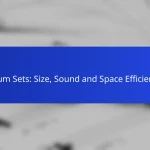Electric guitar amplifiers play a crucial role in shaping your sound, offering various types and features to suit different playing styles and preferences. From beginner-friendly models to more advanced options, understanding wattage, built-in effects, and EQ settings is essential for finding the right match for your needs. Whether you’re practicing at home or performing live, selecting the appropriate amplifier can enhance your overall musical experience.

What are the best electric guitar amplifiers for beginners?
The best electric guitar amplifiers for beginners are typically user-friendly, versatile, and affordable. Models like the Fender Champion 20 and Vox Pathfinder 10 stand out for their sound quality and ease of use, making them ideal choices for new players.
Fender Champion 20
The Fender Champion 20 is a compact and versatile amplifier that offers a range of tones suitable for various music styles. With 20 watts of power and a 8-inch speaker, it provides enough volume for practice and small gigs.
This amp features multiple built-in effects, including reverb and delay, which can enhance your sound without needing additional pedals. Its simple controls make it easy for beginners to dial in their desired tone quickly.
Vox Pathfinder 10
The Vox Pathfinder 10 is another excellent choice for beginners, known for its classic Vox tone in a small package. With 10 watts of power and a 6.5-inch speaker, it’s perfect for home practice and small jam sessions.
This amplifier includes a clean and overdrive channel, allowing players to experiment with different sounds. Its lightweight design and straightforward controls make it an accessible option for those just starting their guitar journey.

What features should I look for in an electric guitar amplifier?
When selecting an electric guitar amplifier, focus on wattage, built-in effects, and EQ settings, as these features significantly impact your sound and performance. Understanding how each feature works will help you choose an amplifier that suits your playing style and environment.
Wattage and volume control
Wattage determines the amplifier’s power output and volume level. For practice at home, an amp with 5 to 20 watts is usually sufficient, while 30 to 50 watts is ideal for small gigs. Higher wattage amps, above 100 watts, are better suited for larger venues.
Volume control is crucial for managing sound levels without distortion. Look for amplifiers with a master volume control and gain settings to balance clean and overdriven tones. This allows you to achieve the desired sound without overwhelming your environment.
Built-in effects and EQ settings
Built-in effects, such as reverb, delay, and distortion, can enhance your sound without needing external pedals. Many modern amplifiers offer a variety of effects, allowing you to experiment with different tones easily. Check for the quality and versatility of these effects to ensure they meet your needs.
EQ settings, including bass, mid, and treble controls, enable you to shape your tone. A good amplifier should have at least a three-band EQ for fine-tuning your sound. Some models offer more advanced EQ options, which can be beneficial for achieving specific tonal characteristics.

How do I choose the right amplifier type for my electric guitar?
Choosing the right amplifier type for your electric guitar depends on your sound preferences, playing style, and intended use. Consider factors like tonal characteristics, reliability, and your budget to make an informed decision.
Tube amplifiers for warmth
Tube amplifiers are known for their rich, warm sound and dynamic response. They produce a natural compression that enhances the musicality of your playing, making them a popular choice for genres like blues and rock.
When selecting a tube amplifier, consider the wattage, as lower wattage models (around 15-30 watts) can provide a great tone at manageable volume levels for home use or small venues. However, higher wattage amps (50 watts and above) are better suited for larger performances.
Keep in mind that tube amps require more maintenance than solid-state options, as the tubes need to be replaced periodically. Ensure you have a budget for this upkeep when considering your purchase.
Solid-state amplifiers for reliability
Solid-state amplifiers use transistors to amplify the signal, offering a more consistent sound and greater reliability than tube amps. They are less prone to failure and can handle a variety of environments, making them ideal for gigging musicians.
These amplifiers typically come in a wider range of power ratings, from small practice amps (around 10-20 watts) to powerful models suitable for larger venues. Solid-state amps often feature built-in effects and EQ options, providing versatility for different playing styles.
While solid-state amplifiers may lack the warmth of tube amps, they excel in clarity and can produce a clean sound at high volumes without distortion. This makes them a great choice for genres like pop and metal where precision is key.

What are the compatibility considerations for electric guitar amplifiers?
Compatibility for electric guitar amplifiers primarily involves matching the amplifier’s specifications with the guitar’s output and connection types. Ensuring proper impedance, connection types, and power ratings can significantly affect sound quality and performance.
Matching impedance with guitar pickups
Impedance matching is crucial for optimal sound transfer between electric guitar pickups and amplifiers. Most electric guitars have pickups with an impedance ranging from 5k to 15k ohms, while amplifiers typically have input impedances around 1M ohm. This mismatch can lead to a loss of tone and volume.
To achieve the best sound, use an amplifier that has a higher input impedance than your guitar’s pickups. This setup allows for better signal transfer and minimizes the risk of tone degradation. If you are unsure, consult your amplifier’s manual or specifications for compatibility details.
Connection types: 1/4″ jack vs. XLR
The most common connection type for electric guitar amplifiers is the 1/4″ jack, which is standard for most electric guitars. This connection is designed for high-impedance signals and is suitable for direct input into amplifiers. In contrast, XLR connections are typically used for microphones and low-impedance signals.
When connecting your guitar to an amplifier, ensure you use the appropriate cable type. Using a 1/4″ jack will provide a better match for electric guitar signals, while XLR connections may require additional adapters or preamps to work effectively. Always check your amplifier’s input options to avoid compatibility issues.

How do I set up my electric guitar amplifier?
To set up your electric guitar amplifier, begin by connecting your guitar to the amp and then adjusting the settings for your desired sound. This process involves ensuring proper connections and fine-tuning controls to achieve optimal audio quality.
Connecting the guitar to the amplifier
Start by using a standard 1/4-inch instrument cable to connect your electric guitar’s output jack to the amplifier’s input jack. Make sure both the guitar and amplifier are turned off before making this connection to avoid any unwanted noise or damage.
Once connected, turn on your amplifier and set the volume to a low level. Gradually increase the volume to a comfortable listening level while playing your guitar. This helps prevent sudden loud sounds that could harm your hearing or the equipment.
Adjusting settings for optimal sound
Begin by adjusting the gain control to set the distortion level. For a clean sound, keep the gain low; for a more distorted tone, increase it gradually. Next, tweak the EQ settings—bass, midrange, and treble—to shape your sound according to your preferences or the style of music you are playing.
Experiment with the reverb and presence controls, if available, to add depth and clarity to your tone. A good starting point is to set reverb at a low level and adjust from there based on your taste. Remember to save your settings for future use, especially if you find a combination that works well for your style.

What are the top brands for electric guitar amplifiers?
Some of the top brands for electric guitar amplifiers include Marshall, Roland, Fender, and Vox. These brands are known for their quality, reliability, and diverse range of products suitable for various playing styles and environments.
Marshall
Marshall amplifiers are iconic in the electric guitar world, recognized for their powerful sound and distinctive tone. They are often favored by rock and metal guitarists, offering a range of models from small practice amps to large, stage-ready stacks.
When choosing a Marshall amp, consider the type of music you play and the amp’s wattage. Lower wattage models are great for home practice, while higher wattage amps are better suited for live performances. Popular models include the Marshall JCM800 and the DSL series, which provide versatile sound options.
Roland
Roland amplifiers are known for their innovative technology and versatility, making them suitable for various genres, including jazz, blues, and pop. Their Cube series is particularly popular among beginners and professionals alike for its portability and built-in effects.
When selecting a Roland amp, look for features like onboard effects and connectivity options. The Cube series offers models with different wattages, allowing you to choose one that fits your practice space or gig requirements. Additionally, Roland amps often include USB connectivity for easy recording and practice integration.

How do I maintain my electric guitar amplifier?
Maintaining your electric guitar amplifier is essential for optimal performance and longevity. Regular upkeep can prevent issues and ensure your sound remains consistent.
Regular cleaning and dusting
Cleaning your amplifier regularly helps prevent dust accumulation that can affect its performance. Use a soft, dry cloth to wipe down the exterior and avoid using harsh chemicals that could damage the finish.
For the interior, it’s advisable to have a professional technician perform a thorough cleaning, especially if you notice any unusual sounds or overheating. Regular checks can help you catch potential issues before they escalate.
Additionally, consider placing your amplifier in a dust-free environment or using a cover when not in use. This simple step can significantly reduce the amount of dust that settles inside and on the surface of the amp.






